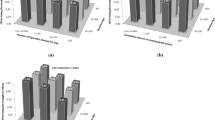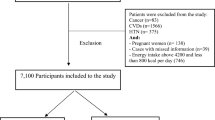Abstract
Objective:
The research aimed at examining betel nut chewing and other risk factors associated with obesity among Taiwanese male adults.
Design:
The research analyzed the data obtained by the 2001 National Health Interview Survey in Taiwan that covered all the administrative divisions in Taiwan. Multistage stratified systematic sampling design was adopted for survey. All members of a sampled household received the interview.
Subjects:
The research analyzed questionnaires answered by nonaboriginal male respondents aged between 20 and 59 years old, and the total number of samples analyzed read 6126. Since very few female subjects chewed betel nut, they were excluded from the analysis.
Measurements:
Criteria of obesity was defined as body mass index⩾27 kg/m2. The variables incorporated for analysis included the respondents' status of betel nut chewing, age, educational background, presence of hypertension and diabetes mellitus, drinking and smoking status, exercise status, and demand for physical strength at job. Generalized estimating equations model was employed to estimate the odd ratios (with 95% CI) of obesity of each independent variable.
Results:
Approximately 16.2% of respondents were obese. The distribution of betel nut chewing was current chewers 15.9%, ex-chewers 4.3%, and nonchewers 79.8%. After controlling above-mentioned independent variables, hypertension, diabetes mellitus, betel nut chewing, never exercising, and sedentary jobs were closely associated with obesity.
Conclusion:
The research found that betel nut chewing closely associated with obesity. The increased appetite of betel nut chewers is speculated as the underlying cause. The prospective study is needed to clarify this issue. In addition to increasing the risk of developing oral cancer, betel nut chewing seemed to be related with another health hazard: obesity.
This is a preview of subscription content, access via your institution
Access options
Subscribe to this journal
Receive 12 print issues and online access
$259.00 per year
only $21.58 per issue
Buy this article
- Purchase on Springer Link
- Instant access to full article PDF
Prices may be subject to local taxes which are calculated during checkout

Similar content being viewed by others
References
Lin YC, Yen LL, Chen SY, Kao MD, Tzeng MS, Huang PC et al. Prevalence of overweight and obesity and its associated factors: findings from National Nutrition and Health Survey in Taiwan, 1993–1996. Prev Med 2003; 37: 233–241.
Warnakulasuriya S . Areca nut use following migration and its consequences. Addict Biol 2002; 7: 127–132.
Boucher BJ, Mannan N . Metabolic effects of the consumption of Areca catechu. Addict Biol 2002; 7: 103–110.
Shieh DH, Chiang LC, Lee CH, Yang YH, Shieh TY . Effects of arecoline, safrole, and nicotine on collagen phagocytosis by human buccal mucosal fibroblasts as a possible mechanism for oral submucous fibrosis in Taiwan. J Oral Pathol Med 2004; 33: 581–587.
Chen PC, Kuo C, Pan CC, Chou MY . Risk of oral cancer associated with human papillomavirus infection, betel quid chewing, and cigarette smoking in Taiwan – an integrated molecular and epidemiological study of 58 cases. J Oral Pathol Med 2002; 31: 317–322.
Lee CH, Ko YC, Huang HL, Chao YY, Tsai CC, Shieh TY et al. The precancer risk of betel quid chewing, tobacco use and alcohol consumption in oral leukoplakia and oral submucous fibrosis in southern Taiwan. Br J Cancer 2003; 88: 366–372.
Yang YH, Lee HY, Tung S, Shieh TY . Epidemiological survey of oral submucous fibrosis and leukoplakia in aborigines of Taiwan. J Oral Pathol Med 2001; 30: 213–219.
Johnston GA, Krogsgaard-Larsen P, Stephanson A . Betel nut constituents as inhibitors of gamma-aminobutyric acid uptake. Nature 1975; 258: 627–628.
Strickland SS, Duffield AE . Anthropometric status and resting metabolic rate in users of the areca nut and smokers of tobacco in rural Sarawak. Ann Hum Biol 1997; 24: 453–474.
Mannan N, Boucher BJ, Evans SJ . Increased waist size and weight in relation to consumption of Areca catechu (betel-nut); a risk factor for increased glycaemia in Asians in east London. Br J Nutr 2000; 83: 267–275.
Sundell J . Obesity and diabetes as risk factors for coronary artery disease: from the epidemiological aspect to the initial vascular mechanisms. Diabet Obes Metab 2005; 7: 9–20.
Carr MC, Brunzell JD . Abdominal obesity and dyslipidemia in the metabolic syndrome: importance of type 2 diabetes and familial combined hyperlipidemia in coronary artery disease risk. J Clin Endocrinol Metab 2004; 89: 2601–2607.
Kriska AM, Saremi A, Hanson RL, Bennett PH, Kobes S, Williams DE et al. Physical activity, obesity, and the incidence of type 2 diabetes in a high-risk population. Am J Epidemiol 2003; 158: 669–675.
Tulloch-Reid MK, Williams DE, Looker HC, Hanson RL, Knowler WC . Do measures of body fat distribution provide information on the risk of type 2 diabetes in addition to measures of general obesity? Comparison of anthropometric predictors of type 2 diabetes in Pima Indians. Diabet Care 2003; 26: 2556–2561.
Mokdad AH, Ford ES, Bowman BA, Dietz WH, Vinicor F, Bales VS et al. Prevalence of obesity, diabetes, and obesity-related health risk factors, 2001. JAMA 2003; 289: 76–79.
Pradhan AD, Skerrett PJ, Manson JE . Obesity, diabetes, and coronary risk in women. J Cardiovasc Risk 2002; 9: 323–330.
Li G, Chen X, Jang Y, Wang J, Xing X, Yang W et al. Obesity, coronary heart disease risk factors and diabetes in Chinese: an approach to the criteria of obesity in the Chinese population. Obes Rev 2002; 3: 167–172.
Ko YC, Chiang TA, Chang SJ, Hsieh SF . Prevalence of betel quid chewing habit in Taiwan and related sociodemographic factors. J Oral Pathol Med 1992; 21: 261–264.
Shih YT, Hung YT, Chang HY, Liu JP, Lin HS, Chang MC et al. The design, contents, operation and the characteristics of the respondents of the 2001 National Health Interview Survey in Taiwan. Taiwan J Public Health 2003; 22: 419–430. [In Chinese].
Department of Health. National Nutrition Status: Nutrition and Health Survey in Taiwan (NAHSIT) 1993–1996. DOH: Taipei, 1999.
Flegal KM, Carroll MD, Ogden CL, Johnson CL . Prevalence and trends in obesity among US adults, 1999–2000. JAMA 2002; 288: 1723–1727.
Soriguer F, Rojo-Martinez G, Esteva dAI, Ruiz de Adana MS, Catala M, Merelo MJ et al. Prevalence of obesity in south-east Spain and its relation with social and health factors. Eur J Epidemiol 2004; 19: 33–40.
Boucher B . Diabetes in British South Asians: nature, nurture, and culture. Diabet Med 1997; 14: 707–708.
Adair LS . Dramatic rise in overweight and obesity in adult filipino women and risk of hypertension. Obes Res 2004; 12: 1335–1341.
Rahmouni K, Correia ML, Haynes WG, Mark AL . Obesity-associated hypertension: new insights into mechanisms. Hypertension 2005; 45: 9–14.
Liu L, Ikeda K, Chen M, Yin W, Mizushima S, Miki T et al. Obesity, emerging risk in China: trend of increasing prevalence of obesity and its association with hypertension and hypercholesterolaemia among the Chinese. Clin Exp Pharmacol Physiol 2004; 31 (Suppl 2): S8–S10.
Wannamethee SG, Shaper AG, Walker M . Overweight and obesity and weight change in middle aged men: impact on cardiovascular disease and diabetes. J Epidemiol Community Health 2005; 59: 134–139.
Mokdad AH, Ford ES, Bowman BA, Dietz WH, Vinicor F, Bales VS et al. Prevalence of obesity, diabetes, and obesity-related health risk factors, 2001. JAMA 2003; 289: 76–79.
Keim NL, Blanton CA, Kretsch MJ . America's obesity epidemic: measuring physical activity to promote an active lifestyle. J Am Diet Assoc 2004; 104: 1398–1409.
Davis AL . Fighting obesity: physical activity has major role. BMJ 2004; 329: 53.
Perbellini L . Job as a risk factor for obesity… and the contrary. Med Lav 2004; 95: 211–222.
Acknowledgements
We thank all the task force members at the Bureau of Health Promotion of DOH, and National Health Research Institutes for their generous assistance in providing the National Health Insurance data and the results of the 2001 National Health Interview Survey in Taiwan.
Author information
Authors and Affiliations
Corresponding author
Rights and permissions
About this article
Cite this article
Chang, WC., Hsiao, CF., Chang, HY. et al. Betel nut chewing and other risk factors associated with obesity among Taiwanese male adults. Int J Obes 30, 359–363 (2006). https://doi.org/10.1038/sj.ijo.0803053
Received:
Revised:
Accepted:
Published:
Issue Date:
DOI: https://doi.org/10.1038/sj.ijo.0803053
Keywords
This article is cited by
-
Areca nut chewing and metabolic syndrome: evidence of a harmful relationship
Nutrition Journal (2013)
-
Areca-nut chewing habit is a significant risk factor for metabolic syndrome: A systematic review
The Journal of nutrition, health and aging (2012)
-
Betel nut extract and arecoline block insulin signaling and lipid storage in 3T3-L1 adipocytes
Cell Biology and Toxicology (2011)
-
Betel Nut Chewing Is Strongly Associated With General and Central Obesity in Chinese Male Middle‐aged Adults
Obesity (2009)
-
Association between obesity and injury among Taiwanese adults
International Journal of Obesity (2009)



